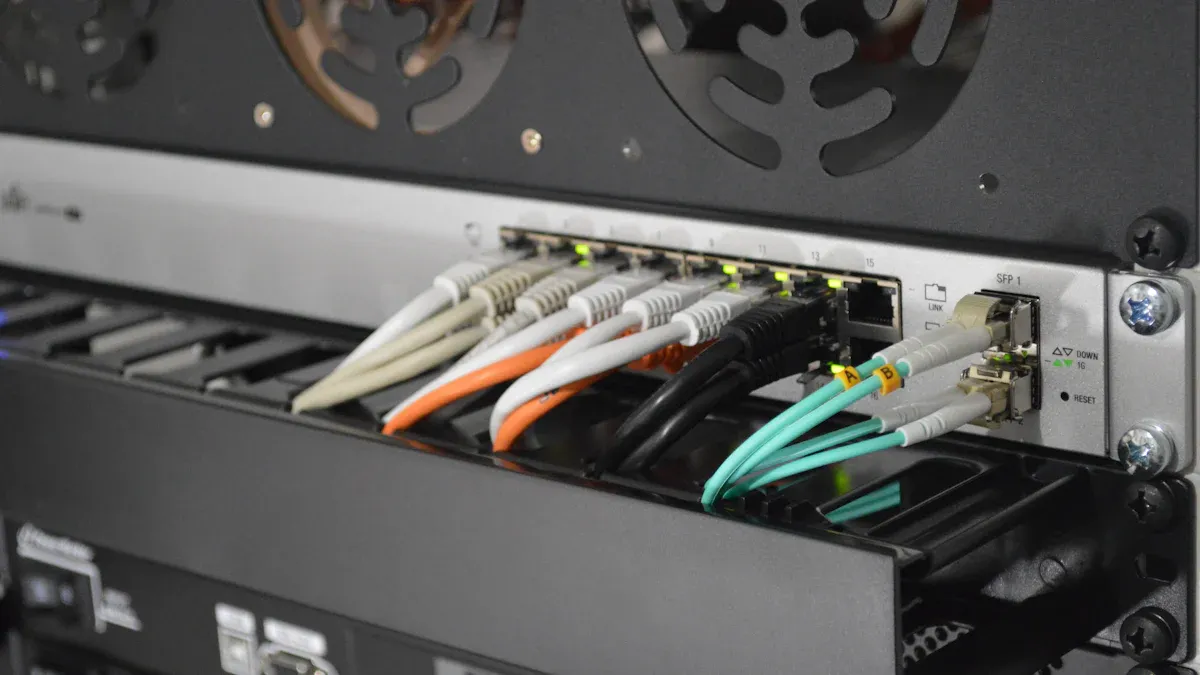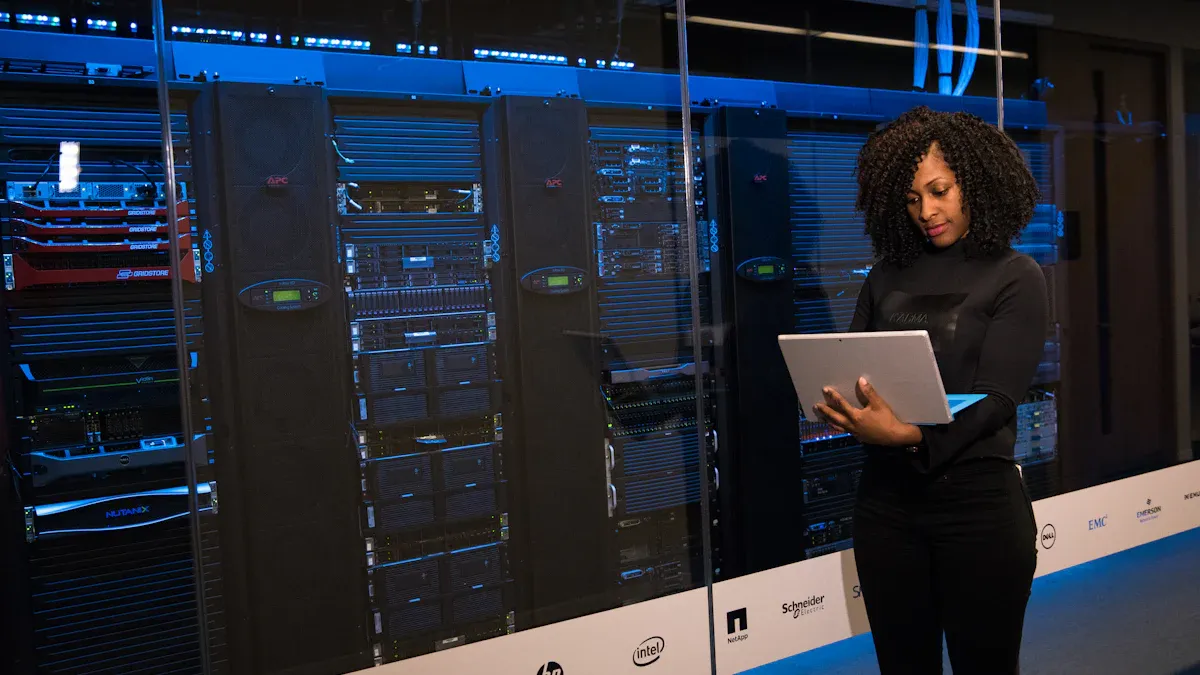
Outlet switched PDUs play a critical role in modern IT infrastructure by enabling precise control over power distribution. These devices allow IT teams to monitor power usage at the outlet level and remotely manage individual outlets. This functionality ensures optimal power levels, reduces energy waste, and enhances operational efficiency. A Ziff-Davis survey revealed that 71% of IT decision makers actively track power consumption, emphasizing the growing importance of such tools. Additionally, an IDC survey identified power provisioning as a top concern in data centers, further highlighting the value of technologies like outlet switched PDUs. Compared to a monitored PDU, outlet switched PDUs offer advanced features that optimize energy usage and improve reliability.
Key Takeaways
- Outlet switched PDUs let you control power from far away. This improves work efficiency and cuts down on downtime.
- They save energy by tracking power use and turning off unused devices. This helps save money.
- Features like power timing and environment checks keep things running well. They also guard important equipment from power spikes.
Understanding Outlet Switched PDUs
Definition and Key Features
An outlet switched PDU is a specialized power distribution unit designed to provide advanced control and monitoring capabilities for IT environments. Unlike traditional PDUs, these devices allow users to manage power at the outlet level, offering precise control over connected equipment. This functionality is essential for optimizing energy efficiency and ensuring operational reliability in modern IT infrastructure.
Key features of outlet switched PDUs include remote power management, per-outlet power sensing, and outlet lockout. Remote power management enables IT administrators to power cycle devices or perform staged power-up sequences from any location. Per-outlet power sensing provides detailed metrics such as current, voltage, and power usage, which are critical for monitoring and optimizing energy consumption. Outlet lockout enhances security by preventing unauthorized access to power outlets. These features collectively make outlet switched PDUs indispensable for data centers and other mission-critical environments.
| Feature | Description |
|---|---|
| Per Outlet Power Sensing | Provides detailed monitoring of current, voltage, and power at each outlet. |
| Remote Power Management | Allows remote control of outlets for power cycling and staged startups. |
| Outlet Lockout | Prevents unauthorized equipment installation, ensuring secure operations. |
| Power Management | Reduces energy waste by managing power on a per-outlet basis. |
How Outlet Switched PDUs Differ from Other PDU Types
Outlet switched PDUs stand out due to their ability to combine monitoring and control functionalities. Unlike basic PDUs, which only distribute power, or metered PDUs, which measure power usage without control capabilities, outlet switched PDUs offer remote management of individual outlets. This feature is particularly valuable in environments requiring flexibility and quick responses to power issues.
Metered PDUs excel in providing precise power consumption data but lack the control features of switched PDUs. In contrast, outlet switched PDUs enable IT teams to remotely reboot devices, manage power distribution, and even lock specific outlets to prevent misuse. These advanced capabilities make them ideal for dynamic IT environments where both monitoring and control are critical.
- Switched PDUs allow remote control of individual outlets, enhancing flexibility.
- Metered PDUs focus solely on measuring power consumption.
- The choice between these types depends on the specific needs of the IT infrastructure.
Benefits of Outlet Switched PDUs

Enhanced Power Management and Energy Efficiency
Outlet switched PDUs provide advanced tools for managing power consumption and improving energy efficiency. These devices allow IT administrators to monitor and control power usage at the outlet level, ensuring that energy is allocated only where it is needed. By shutting down idle devices, they help reduce unnecessary power consumption. Power sequencing, another key feature, prevents power surges by staggering the startup of connected equipment. This not only protects devices but also optimizes energy usage across the infrastructure.
Key benefits include:
- Remote Outlet Control: Enables individual outlet management from a distance.
- Power Sequencing: Prevents surges by staggering equipment startup.
- Optimized Energy Usage: Reduces power consumption by shutting down idle devices.
- Environmental Monitoring: Tracks temperature and humidity to ensure equipment safety.
These features make outlet switched PDUs an essential component for organizations aiming to achieve energy efficiency and cost savings.
Remote Accessibility and Control
The ability to manage power remotely is a game-changer for IT teams. Outlet switched PDUs allow administrators to control individual outlets from any location, enabling them to reboot devices, perform diagnostics, and manage power distribution without being physically present. This capability significantly reduces the time and effort required to address power-related issues.
“It only takes one or two instances of a locked up server being remotely reset to pay for the functionality of a Switched PDU,”
— Michael Weinrich, Senior DevOps Engineer, Picturemaxx
This level of accessibility enhances operational efficiency and ensures that IT teams can respond quickly to challenges, even in remote or distributed environments.
Downtime Prevention and Reliability
Outlet switched PDUs play a critical role in preventing downtime and ensuring system reliability. Features like remote outlet control and power sequencing ensure stable device operation and prevent unexpected outages. Dual power inputs provide redundancy, automatically switching to a secondary power source if the primary one fails. Hot-swappable power modules allow for maintenance without disrupting operations, making them ideal for mission-critical environments.
| Feature | Description |
|---|---|
| Remote Outlet Control | Enables administrators to turn outlets on or off remotely, preventing downtime. |
| Power Sequencing | Ensures devices power up in a controlled manner to prevent power surges and ensure stable startup. |
| Dual Power Inputs | Provides redundancy by automatically switching to a secondary power input if one fails. |
| Hot-Swappable Power Modules | Allows for easy maintenance and repair without downtime, crucial for mission-critical environments. |
By integrating these features, outlet switched PDUs enhance system reliability and minimize the risk of costly disruptions.
Applications of Outlet Switched PDUs
Data Centers and Server Rooms
Data centers and server rooms rely heavily on outlet switched PDUs to maintain operational efficiency and reliability. These environments demand precise power management to support high-density equipment and prevent downtime. Remote management capabilities allow IT administrators to control power distribution and switch outlets from any location, reducing the need for on-site intervention. This feature significantly improves maintenance response times, as studies show a 40% improvement when remote monitoring is utilized.
Outlet switched PDUs also enhance energy efficiency by providing real-time power monitoring at the rack and outlet levels. This visibility enables administrators to identify and shut down idle devices, reducing energy waste by up to 20%. Additionally, integrated surge protection and circuit breakers safeguard critical equipment, minimizing the risk of costly outages. These features make outlet switched PDUs indispensable for modern data centers.
| Benefit/Feature | Description |
|---|---|
| Remote Management | Enables IT administrators to control power distribution and outlet switching from any location. |
| Power Monitoring | Provides detailed power monitoring at the rack and outlet levels in real-time. |
| Energy Efficiency | Can reduce energy waste by up to 20% with improved monitoring and adjustments. |
| Increased Security | Includes surge protection and circuit breakers to minimize risks of downtime. |
Telecommunications and Networking
Telecommunications and networking setups benefit greatly from the advanced features of outlet switched PDUs. Remote outlet control allows IT teams to power cycle devices instantly, ensuring minimal disruption to operations. Power monitoring provides detailed metrics for each outlet, enabling better resource allocation and operational efficiency.
Environmental monitoring is another critical feature. By tracking temperature and humidity, outlet switched PDUs help maintain optimal conditions for sensitive networking equipment. This proactive approach reduces the likelihood of equipment failure due to environmental factors. These capabilities make outlet switched PDUs a vital component in telecommunications infrastructure.
- Remote outlet control allows for immediate power cycling of devices.
- Power monitoring provides detailed metrics per outlet, enhancing operational efficiency.
- Environmental monitoring supports temperature and humidity tracking, ensuring optimal conditions.
Edge Computing and Remote Sites
Edge computing and remote sites often operate in challenging environments where physical access is limited. Outlet switched PDUs address these challenges by offering remote monitoring and management capabilities. IT teams can manage power loads, reboot devices, and monitor environmental conditions without visiting the site. This reduces operational costs and ensures consistent uptime.
Power measurement at the outlet level provides detailed insights into energy usage, helping organizations optimize power consumption. Environmental monitoring features, such as temperature and humidity alerts, ensure equipment operates within safe limits. Additionally, scheduling power loads for inactive devices minimizes energy waste, improving overall efficiency. These features make outlet switched PDUs essential for edge computing and remote site operations.
| Feature | Description |
|---|---|
| Remote Monitoring | Allows for the management of power loads without physical access. |
| Power Measurement | Provides detailed metrics per outlet, essential for optimizing power usage. |
| Environmental Monitoring | Alerts for temperature and humidity, ensuring equipment operates within safe limits. |
| Remote Rebooting | Enables quick recovery from server issues without technician intervention. |
| Scheduling Power Loads | Helps reduce waste by managing power to inactive devices. |
Key Features to Consider in Outlet Switched PDUs
Real-Time Monitoring and Reporting
Real-time monitoring and reporting capabilities are essential for ensuring efficient power management in IT environments. Outlet switched PDUs excel in providing detailed insights into power usage, outlet status, and environmental conditions. These features allow IT administrators to make informed decisions and respond promptly to potential issues.
Advanced reporting tools integrate seamlessly with SNMP protocols and APIs, enabling data to be sent to central servers or Data Center Infrastructure Management (DCIM) systems. This integration ensures that power metrics are accessible and actionable. Comprehensive logging further enhances operational efficiency by maintaining detailed records of power consumption and environmental metrics.
| Feature | Description |
|---|---|
| Comprehensive Logging | Detailed logging capabilities for power usage, outlet status, and environmental metrics. |
| Advanced Reporting | Integration with SNMP and APIs for sending data logs to central servers or DCIM systems. |
These features make real-time monitoring and reporting indispensable for maintaining operational reliability and optimizing energy usage.
Load Balancing and Redundancy
Load balancing and redundancy are critical for preventing power overloads and ensuring uninterrupted operations. Outlet switched PDUs distribute power evenly across connected devices, reducing the risk of circuit overloads. This capability is particularly valuable in high-density environments like data centers, where power demands fluctuate frequently.
Redundancy features, such as dual power inputs, provide an additional layer of reliability. If one power source fails, the PDU automatically switches to the secondary source, ensuring continuous operation. This functionality minimizes downtime and protects sensitive equipment from unexpected power disruptions.
By incorporating load balancing and redundancy, outlet switched PDUs enhance both system stability and operational efficiency, making them a cornerstone of modern IT infrastructure.
Safety Compliance and Certifications
Safety compliance is a non-negotiable aspect of power distribution in IT environments. Outlet switched PDUs adhere to stringent safety standards to ensure reliable and secure operations. Features like open neutral protection prevent unexpected energization caused by wiring failures, while Ground Fault Circuit Interrupter (GFCI) protection detects ground faults to enhance safety.
Compliance with the National Electrical Code (NEC) further validates the safety and reliability of these devices. Organizations can trust that their power distribution systems meet industry standards, reducing the risk of electrical hazards.
| Requirement | Description |
|---|---|
| Open Neutral Protection | Prevents unexpected energization due to wiring failures. |
| GFCI Protection | Enhances safety by detecting ground faults. |
| NEC Compliance | Ensures installations meet the National Electrical Code. |
These certifications and safety features underscore the reliability of outlet switched PDUs, making them a trusted choice for mission-critical applications.
Comparing Outlet Switched PDUs with Other PDU Types
Basic PDUs
Basic PDUs serve as the simplest form of power distribution units. They function primarily as power strips, offering a fixed number of outlets for connecting devices. While some models include optional surge suppression to protect against voltage spikes, they lack advanced features like monitoring or remote management. Basic PDUs often incorporate locking and color-coded receptacles to enhance safety and organization. However, they do not support internet connectivity or graphical user interfaces, limiting their utility in larger or critical IT environments.
- Advantages: Affordable and reliable for small-scale setups.
- Disadvantages: Lack of instrumentation and remote management capabilities.
These units are best suited for smaller server rooms or non-critical applications where simplicity and cost-effectiveness are priorities.
Metered PDUs
Metered PDUs provide a step up from basic models by offering real-time power consumption data. They measure key metrics such as current, voltage, and power usage, enabling IT teams to monitor energy efficiency and prevent overloads. These devices are particularly useful for identifying underutilized equipment and balancing loads in racks with redundant power supplies.
| Measurement Type | Description |
|---|---|
| Current (A) | Tracks the electrical current being consumed. |
| Voltage (V) | Indicates the voltage level supplied to the PDU. |
| Kilowatt-hour (kWh) | Measures total energy consumed over time, aiding efficiency assessments. |
| Alerts for Thresholds | Triggers alerts when predefined thresholds are exceeded. |
Metered PDUs excel in environments where monitoring power usage is essential but remote control is not required.
Monitored PDUs
Monitored PDUs combine the power measurement capabilities of metered units with additional features like environmental integration. These devices monitor power usage and environmental conditions such as temperature and humidity in real time. They also support redundancy through dual power inputs, ensuring continuous operation even during power source failures.
- Key Features:
- Integration with environmental sensors for proactive monitoring.
- Real-time alerts for power and environmental thresholds.
- High reliability and cost-effectiveness for critical applications.
Compared to a monitored PDU, an outlet switched PDU offers the added advantage of remote outlet control, making it ideal for dynamic IT environments requiring both monitoring and management.
Future Trends in Outlet Switched PDU Technology

AI Integration and Smarter Power Management
Artificial intelligence is transforming the capabilities of outlet switched PDUs, enabling smarter power management and operational efficiency. AI-powered PDUs now provide predictive maintenance by analyzing power usage patterns to forecast potential issues. This proactive approach reduces downtime and enhances reliability. Additionally, AI enables real-time adjustments in power distribution, ensuring systems can handle sudden spikes in demand without compromising performance.
The growing adoption of IoT devices, projected to reach 73 billion by 2025, further emphasizes the need for advanced monitoring capabilities in PDUs. Automation, powered by AI, allows dynamic adjustments to fluctuating energy demands, optimizing power usage across IT infrastructures. These advancements position AI as a cornerstone of future PDU technology, revolutionizing how data centers and edge computing sites manage power.
Green Technology and Sustainability
Sustainability is becoming a critical focus in PDU design. Organizations are increasingly adopting green technologies to reduce energy consumption and environmental impact. Outlet switched PDUs contribute to this goal by enabling precise power management, which minimizes energy waste. Features like power sequencing and real-time monitoring allow IT teams to identify and shut down idle devices, reducing unnecessary power usage.
Surveys reveal that 71% of IT decision-makers actively track power consumption, highlighting the growing emphasis on energy efficiency. As data centers expand, the integration of sustainable practices in PDU technology will play a pivotal role in addressing power provisioning concerns while supporting global sustainability goals.
Enhanced Security Features
Enhanced security features are becoming a standard in modern outlet switched PDUs. These devices now include outlet-level switching, secure locking mechanisms, and authentication logging to prevent unauthorized access. Advanced features like secure syslog protocol support and automatic firmware updates ensure systems remain protected against evolving threats.
| Feature | Description |
|---|---|
| Authentication Logging | Tracks configuration changes and system events for auditing purposes. |
| Secure Locking Mechanisms | Prevents unauthorized physical access to outlets. |
| Automatic Firmware Updates | Keeps systems updated with the latest security patches. |
| SNMP Traps | Sends alerts for proactive management of power and security issues. |
These innovations enhance both operational efficiency and security, making outlet switched PDUs indispensable for mission-critical environments.
Outlet switched PDUs have revolutionized power management in IT infrastructure by enabling remote control, outlet-level switching, and sequential power-up. These features enhance operational efficiency and reduce costs. Experts like Michael Weinrich emphasize their value in managing locked servers remotely. Organizations seeking reliable and efficient power solutions should consider adopting this technology.
FAQ
What is the primary purpose of an outlet switched PDU?
An outlet switched PDU provides precise power control and monitoring at the outlet level. It ensures energy efficiency, operational reliability, and remote management for IT environments.
How do outlet switched PDUs improve energy efficiency?
They allow IT administrators to monitor power usage per outlet, shut down idle devices, and optimize energy distribution. These features reduce unnecessary power consumption and operational costs.
Can outlet switched PDUs prevent downtime?
Yes, they enhance reliability through features like remote outlet control, power sequencing, and dual power inputs. These capabilities minimize disruptions and ensure consistent system performance.
Post time: Mar-26-2025

